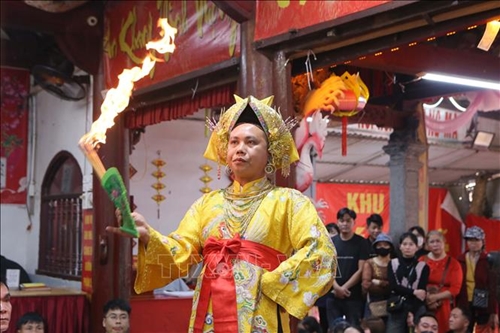According to cultural researchers and historians, this belief system stands out as one of the country’s most enduring and widespread folk practices. Tracing its origins back thousands of years, the worship of Mother Goddesses has evolved alongside the Vietnamese nation, intertwining with its struggles, triumphs, and the spiritual lives of its people. Passed down through countless generations, this tradition has not only survived but also thrived, preserving the legacy of heroic national figures and mythological stories that resonate with the Vietnamese identity.
A deeply indigenous spiritual tradition
Over the past several years, the practice of Mother Goddess worship has seen a notable resurgence across various provinces in Vietnam, particularly in the Northern region. This cultural and spiritual revival has brought renewed attention to its unique rituals and symbolic meanings. Among the many localities that actively practice this belief, Nam Dinh province stands out as a significant center. With approximately 600 recognized sites devoted to Mother Goddess worship, Nam Dinh is widely considered a spiritual hub for followers and practitioners of this tradition.
    |
 |
|
A Hầu đồng practice in Nam Dinh province (Photo: VNA) |
At the heart of the Mother Goddess worship lies the vibrant and dynamic ritual known as "Hau dong." This ceremony is a pivotal aspect of the tradition, where spirit mediums – often dressed in colorful, elaborate costumes – enter into a trance and embody different deities associated with the Three Realms: Heaven, Earth, and Water. Through this performance, they deliver blessings, guidance, and comfort to the people. For believers, "Hau dong" is more than just a ritual; it serves as a bridge between the physical and spiritual worlds, helping individuals connect with divine forces and pursue their desires for happiness, prosperity, and inner peace. It is this symbolic and spiritual richness that continues to draw interest and reverence from local communities and beyond.
The worship of Mother Goddesses is not only rich in symbolic meaning but also possesses distinct cultural characteristics that highlight Vietnam's indigenous heritage. Recognizing the importance of this tradition, UNESCO officially acknowledged it in 2016 by adding the worship of Mother Goddesses of the Three Realms to its Representative List of the Intangible Cultural Heritage of Humanity. This designation has further elevated the global profile of the practice and emphasized its role as a living cultural treasure of the Vietnamese people.
Dr. Nguyen Ngoc Mai, who leads the Department of Religious Studies at the Vietnam Academy of Social Sciences, has emphasized the unique position that this belief occupies in comparison with other religious and cultural practices found across Vietnam. She noted that while many belief systems focus on worshippers venerating deities, the Mother Goddess tradition is distinguished by the roles assumed by its practitioners. In "Hau dong," the mediums do not simply offer prayers or tributes; they become the deities themselves, embodying their spirits and communicating their will to the faithful. This dual role of devotee and divine representative sets the tradition apart as a particularly immersive and participatory form of spirituality.
Safeguarding cultural heritage in the era of global integration
To promote and protect the enduring value of the Mother Goddess worship tradition, Vietnam has taken proactive steps in recent years. In late 2023, the Ministry of Culture, Sports and Tourism, in collaboration with the People’s Committee of Nam Dinh province, hosted a significant conference and academic seminar. This event marked the 20th anniversary of the UNESCO Convention for the Safeguarding of the Intangible Cultural Heritage (2003-2023). It also served as a platform to evaluate how effectively this international agreement has been implemented in relation to the practice and preservation of Mother Goddess worship within Vietnam.
Over the past two decades, the Vietnamese government, in partnership with local authorities and various ethnic communities, has made commendable progress in aligning with UNESCO's 2003 Convention. These collective efforts have led to meaningful protection and revitalization of numerous cultural practices. A prime example of such initiatives occurred in October 2023, when the Thuong Ngan Mother Goddess Worship and the New Rice Festival were celebrated at Dong Cuong Temple, a national cultural and historical site in Yen Bai province. Events like these not only revitalize local cultural identity but also provide educational and spiritual enrichment for younger generations.
However, for these efforts to remain sustainable and impactful, institutional support must be further strengthened. Assoc. Prof., Dr. Le Thi Thu Hien, Director of the Department of Cultural Heritage at the Ministry of Culture, Sports and Tourism, has emphasized the necessity of developing a more comprehensive legal framework. This would include detailed regulations and guidelines for managing and practicing intangible cultural heritage. Additionally, clearer policies on the responsible use and promotion of these traditions are needed, particularly for sacred or ceremonial elements. Regular oversight, enhanced government involvement, and thoughtful regulation will help preserve the authenticity of practices such as Mother Goddess worship while allowing them to flourish in a modernizing society.
Moreover, the annual Mother Goddess rituals organized throughout the country are not only significant spiritual events but also play a growing role in the promotion of cultural and religious tourism. These festivals attract both local devotees and international visitors, including members of the Vietnamese diaspora seeking to reconnect with their ancestral heritage. The spiritual tourism associated with Mother Goddess worship enhances national cultural identity while offering economic opportunities for communities engaged in its practice.
In essence, the promotion and safeguarding of the Mother Goddess worship tradition is about much more than preserving rituals. It represents a broader commitment to upholding Vietnam’s cultural sovereignty in a world of increasing globalization. By honoring and protecting this intangible heritage, Vietnam reinforces its national identity, fosters unity among its people, and showcases the resilience and beauty of its spiritual traditions to the world. The journey of the past 20 years demonstrates that with dedicated stewardship and thoughtful engagement, cultural heritage can be both a living tradition and a source of inspiration for generations to come.
Translated by Anh Ngoc